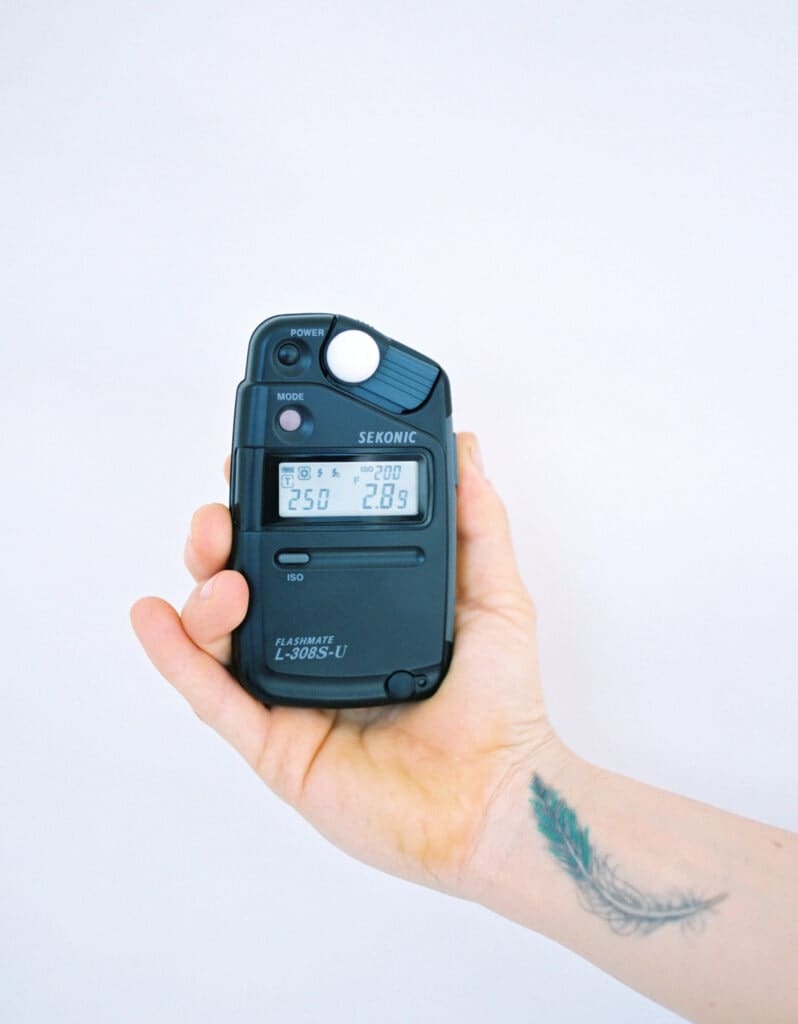Do I really even need a light meter?
We get it. You just started shooting film and you’re told to get another piece of equipment. We know what you’re thinking, “My camera has an internal light meter. Can’t I just use that?” The answer is no. Well, technically, yes, you can — but if you’re looking for consistent, professional grade results, you need a tool that can get you there.
Why should I use an external light meter?
Your in-camera light meter reads the light being reflected off your subject. It also takes in all the light reflected from the scene. This can sometimes result in your subject being too dark or too light because the meter was fooled by the brightness or darkness of the scene, and compensated to create an average exposure. But who wants average?
By using an external meter, you can bypass the reflected light altogether and measure the light source itself. This will result in more consistent and accurate measurements of the light on your subject, and you’ll know what to expect from your exposures.
What does a light meter tell you?
Similar to your camera, you can choose a mode for your light meter when shooting film. If you input the aperture, you can have it measure the light and tell you which shutter speed to use. If you input your preferred shutter speed, your light meter can tell you which aperture to use.

What does it mean to “rate,” film?
You can’t change the sensitivity of film. However, you can “lie,” to your light meter by telling it a higher or lower sensitivity in order to intentionally over or underexpose when shooting film.
For instance, if you have Portra 400 and you want to consistently overexpose it by one stop, you can “rate” it at 200 by setting your light meter to ISO 200. Now your meter thinks your 400 speed film is actually 200 speed film, so the shutter speed and aperture settings recommended will compensate for the lower sensitivity, resulting in images that are over exposed.
Is this the same as pushing and pulling?
No- pushing and pulling are done while chemically developing the film, not while exposing it. We always recommend avoiding the, “I’ll fix this in post,” mindset when shooting film or any other kind of media. Save yourself time (and money!) and don’t press that shutter until you are confident it’s right.
How should I use a light meter?
When shooting film, if you know what aperture you want to use and you know the ISO of your film (or what you want to rate it as), input those two factors into the meter. Click the button to measure the light, with the meter facing TOWARD you.
Now you know what shutter speed to use! Input that into your camera, in manual mode.
How often should I meter?
Remember to re-meter when you shift into a different light source or if the weather changes. If you are prone to forgetting to re-meter, you may want to get in the habit of re-metering at least every time you load a new roll of film, or twice for each roll.
Which light meter do you recommend?
We recommend the Sekonic L-358 because it is reliable and has the basic controls needed for film photography. The L-358 can only be purchased used, on eBay or marketplace.
Another great meter is the Sekonic L-308X-U (specifically the XU version). This model is a bit smaller, also has all the basic controls needed, and is available to purchase new.
What is the sunny 16 rule?
If you don’t have a light meter, try out the “sunny 16” rule. If, when shooting film, you are in full, bright sun, set your aperture to 16. Your shutter speed will correspond with the box speed of whatever film you are using. Portra 400 is ISO 400, so you’d use a shutter speed of 1/400. Kodak gold is ISO 200, so you’d want a shutter speed of 1/200. From here, you can change the aperture and shutter speed accordingly to get the balance you want, using the exposure triangle (more on that coming soon!)
How can I test this?
If you are new to shooting film or photography or using a new light meter, we recommend doing a test roll. This is a good chance to test your new light meter and also to see which settings you can use to get the results you want. When you get your scans back with your signature order, don’t forget to review your contact sheet – it’s a great tool to use to understand how well you exposed your film, and some cameras will even record the settings used right onto the film frames!
Everything from disposable cameras to medium format film, we’ve got what you need to get started!
